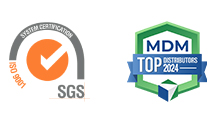According to the Bureau of Labor Statistics (BLS), fatal injuries in confined spaces average out to 92 per year (almost 2 per week).
Confined spaces present a unique challenge and can often be more hazardous than regular workspaces. It is important for you to take the necessary steps to provide your employees with the proper equipment, training and programs to ensure they stay safe.
What is a Confined Space?
Many workplaces contain areas that are considered “confined spaces” because while they are not necessarily designed for people, they are large enough for workers to enter and perform certain jobs. A confined space has limited or restricted means for entry or exit and is not designed for continuous occupancy.
Confined spaces can be either above or below ground, and despite their name not necessarily small. Examples of confined spaces include silos, vats, hoppers, utility vaults, tanks, sewers, pipes, access shafts, truck or rail tank cars, aircraft wings, boilers, manholes, manure pits, vessels, storage bins, tunnels, equipment housings, duct work, pipelines, etc.
What Types of Hazards Exist in a Confined Space?
- Poor air quality; There may be an insufficient amount of oxygen present, or the atmosphere might contain a poisonous substance
- Inhalation of bad air or chemical exposure
- Fire hazard; There may be an explosive/flammable atmosphere due to flammable liquids that can ignite, leading to a fire or explosion
- Process related hazards such as residual chemicals, release of contents of a supply line
- Temperature extremes including atmospheric and surface
- Shifting or collapse of bulk material, including barrier failure resulting in flooding
- Electrical shock
- Biological hazards
Additionally, Occupational Safety and Health Administration (OSHA) uses the term “permit-required confined space” (permit space) to describe a confined space that has one or more of the following characteristics: contains or has the potential to contain a hazardous atmosphere; contains a material that has the potential to engulf an entrant; has walls that converge inward or floors that slope downward and taper into a smaller area which could trap or asphyxiate an entrant; or contains any other recognized safety or health hazard, such as unguarded machinery, exposed live wires, or heat stress.
Why are Confined Spaces More Hazardous Than Other Workspaces?
Confined spaces have a smaller margin for error and have more serious consequences if mistakes are made. In some cases, the conditions in a confined space are extremely hazardous and often unpredictable.
Some examples include:
- The entrance/exit might not allow a worker to get out in time if there is a flood or collapse
- Self-rescue and rescues are more difficult as confined spaces do not allow easy movement of people or equipment.
- Natural ventilation alone is often not sufficient to maintain breathable quality air
- Conditions can chance very quickly
- The space outside of a confined space can impact conditions internally
Steps to Protect Your Employees
1. Evaluate Your Workplace
Employers must evaluate their workplaces to determine if spaces are permit spaces. If a workplace contains permit spaces, the employer must inform exposed employees that they exist, where they exist, and the hazards they pose. One way to communicate this is with signage such as “DANGER”PERMIT-REQUIRED CONFINED SPACE”AUTHORIZED ENTRANTS ONLY” or something very similar.
2. Develop a Written Program
Employers must take effective measures to prevent their workers from entering these spaces. If employees are expected to enter permit spaces, the employer must develop a written permit space program and make it available to employees or their representatives.
In fact, any employer who allows employee entry into a permit space must develop and implement a written program for the space. Among other things, the OSHA standard requires the employer’s written program to:
- Implement necessary measures to prevent unauthorized entry;
- Identify and evaluate permit space hazards before allowing employee entry;
- Test atmospheric conditions in the permit space before entry operations and monitor the
space during entry; - Perform appropriate testing for the following atmospheric hazards in this sequence: oxygen, combustible gases or vapors, and toxic gases or vapors;
- Establish and implement the means, procedures and practices to eliminate or control hazards necessary for safe permit space entry operations;
- Identify employee job duties;
- Provide and maintain, at no cost to the employee, personal protective equipment and any other equipment necessary for safe entry and require employees to use it;
- Ensure that at least one attendant is stationed outside the permit space for the duration of entry operations;
- Coordinate entry operations when employees of more than one employer are working in the permit space;
- Implement appropriate procedures for summoning rescue and emergency services and preventing unauthorized personnel from attempting rescue;
- Establish in writing, and implement a system for the preparation, issue, use and cancellation of entry permits;
- Review established entry operations annually and revise the permit space entry program as necessary; and
- Implement the procedures that any attendant who is required to monitor multiple spaces will follow during an emergency in one or more of those spaces.
3. Control Hazards
OSHA further stipulates that an employer’s written program should establish the means, procedures and practices to eliminate or control hazards necessary for safe permit space entry operations. This includes specifying acceptable entry conditions, isolating the permit space, providing barriers, verifying acceptable entry conditions, and purging, making inert, flushing or ventilating the permit space.
In addition to personal protective equipment, other equipment that employees may require for safe entry into a permit space includes: testing, monitoring, ventilating, communications and lighting equipment, barriers and shields, ladders, and retrieval devices.
4. Detect and Prevent Unauthorized Entry
If hazardous conditions are detected during entry, employees must immediately leave the space. The employer must evaluate the space to determine the cause of the hazardous atmosphere and modify the program as necessary.
When workers are prohibited from entering permit spaces, the employer must take effective measures to prevent unauthorized entry. Non-permit confined spaces must be evaluated when changes occur in their use or configuration and, where appropriate, must be reclassified as permit spaces.
It’s important to note that a space with no potential to have atmospheric hazards may be classified as a non-permit confined space only when ALL hazards are eliminated in accordance with the standard. If entry is required to eliminate hazards and obtain data, the employer must follow specific procedures in the standard.
Protecting your employees and developing a comprehensive confined space program can often be a challenge. Arbill offers Confined Space training that is designed to teach the worker to recognize the spaces and hazards, recognize the health effects of exposure, proper selection and use of PPE, and the duties and responsibilities for the confined space entrants.
Arbill also offers Confined Space Rescue Training for any individuals who during the course of their employment is expected to make rescues from confined spaces. A combination of drills and classes will take place to teach the proper response to chemical emergencies or other confined space issues by personnel expected to make rescues.
Contact an Arbill EH&S Training Expert today, for more information on confined space training and program development.














